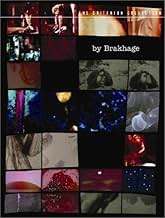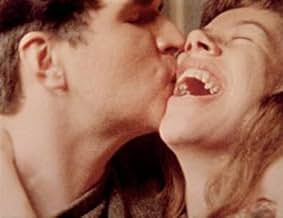Window Water Baby Moving
- 1959
- 13min
VALUTAZIONE IMDb
7,5/10
2546
LA TUA VALUTAZIONE
Aggiungi una trama nella tua linguaStan Brakhage films the birth of his first child, Myrrena.Stan Brakhage films the birth of his first child, Myrrena.Stan Brakhage films the birth of his first child, Myrrena.
Stan Brakhage
- Self
- (non citato nei titoli originali)
Myrrena Schwegmann
- Self (baby being born)
- (non citato nei titoli originali)
Jane Wodening
- Self
- (non citato nei titoli originali)
Recensioni in evidenza
An amazing avant-garde short of the birth of Brakhage's first child. This film is both graphic and beautiful while effecting each viewer a little differently. The colors in the film are especially striking. (Warning this film is not for the queazy).
Window Water Baby Moving (1962)
**** (out of 4)
I'm not quite sure where the line is drawn when it comes to art and a simple home movie but this film is certainly the best of both. Director Brakhage made this eleven-minute film dealing with the birth of his first child. The mixture of something beautiful like art and something ugly like a home movie is rather interesting for the story as there's a lot of ugliness that goes along with childbirth but at the same time there's also something beautiful about it and this film perfectly captures both. Nothing during the birth sequence is kept to the imagination as the director gets the camera very close to where all the action is going on and he doesn't shy away from showing anything. It's rather amazing that his wife was such a good sport because there had to be times where he was in the way of the birth just to get certain shots. The film shows a lot of this ugly, bloody mess but it's also done very beautifully. The birth shots and edited with shots of Brakhage and his wife loving on one another and the way this editing is done really captures the love and affection the director must have been feeling.
**** (out of 4)
I'm not quite sure where the line is drawn when it comes to art and a simple home movie but this film is certainly the best of both. Director Brakhage made this eleven-minute film dealing with the birth of his first child. The mixture of something beautiful like art and something ugly like a home movie is rather interesting for the story as there's a lot of ugliness that goes along with childbirth but at the same time there's also something beautiful about it and this film perfectly captures both. Nothing during the birth sequence is kept to the imagination as the director gets the camera very close to where all the action is going on and he doesn't shy away from showing anything. It's rather amazing that his wife was such a good sport because there had to be times where he was in the way of the birth just to get certain shots. The film shows a lot of this ugly, bloody mess but it's also done very beautifully. The birth shots and edited with shots of Brakhage and his wife loving on one another and the way this editing is done really captures the love and affection the director must have been feeling.
You ever see that cliché happening, if not in TV or movies then in real life, of the husband documenting every single excruciatingly painful but miraculous happening that is birth? Apparently, according to Stan Brakhage on the DVD this film is on, this trend was at least in part inspired by his original efforts. Shot on a minimal budget (save for what it must've cost to have a birth in the Brakhage household as opposed to the hospital), this film IS the difference between a simple 'home movie' and something close to the most personal art possible. Documentary film-making has always been about a subject that compels the filmmaker enough to get hours and hours of footage down. That here Brakhage, who often does montage work of paintings and the like, is focusing his subject matter on his wife, and his child just itching to get out, in all graphic detail, is astounding. For the 60's, when this was first released, it was probably a lot more shocking than now.
Not to say that the film isn't shocking, but it is on a different level than what you might see on one of those 'birth' shows on one of the Discovery channels. The way certain things are presented in the film are surprising, and (if you're a guy like me) definitely unnerving. But Brakhage somehow makes his film almost beautiful in a way by cutting the film's subject matter in half, so to speak. The first half is just the mother of his child, in a bathtub, feeling the baby kicking, et all. It's really just a great montage of the woman as a whole, nothing unseen, with the belly getting the most screen-time aside from the mother's face and genitals. Then comes the second part, the birth. Basically, if you still wonder how it works, in near unflinching detail, watch the film. That it is presented in such a grainy 16mm kind of filming, and still using the intense, mad montage of Brakhage's two cameras on her (I think it was two, one more close to the 'action' than the other).
And when it ends, it is, like all (practically) successful births, a miracle in and of itself. So much happens within these 13 minutes of film than, in a way, it feels longer. I loved how it dealt with its subject matter, which could be very tricky, and messy (the latter of which is very true), and was still a wonder for the eyes. It lacks music, which is sort of a pro and a con for me- you could do with some music, make it even more home movie-like. As it is, Brakhage has one of his most notorious- and possibly best- works here, and maybe the only film that makes that bridge between a health class and film class in school.
Not to say that the film isn't shocking, but it is on a different level than what you might see on one of those 'birth' shows on one of the Discovery channels. The way certain things are presented in the film are surprising, and (if you're a guy like me) definitely unnerving. But Brakhage somehow makes his film almost beautiful in a way by cutting the film's subject matter in half, so to speak. The first half is just the mother of his child, in a bathtub, feeling the baby kicking, et all. It's really just a great montage of the woman as a whole, nothing unseen, with the belly getting the most screen-time aside from the mother's face and genitals. Then comes the second part, the birth. Basically, if you still wonder how it works, in near unflinching detail, watch the film. That it is presented in such a grainy 16mm kind of filming, and still using the intense, mad montage of Brakhage's two cameras on her (I think it was two, one more close to the 'action' than the other).
And when it ends, it is, like all (practically) successful births, a miracle in and of itself. So much happens within these 13 minutes of film than, in a way, it feels longer. I loved how it dealt with its subject matter, which could be very tricky, and messy (the latter of which is very true), and was still a wonder for the eyes. It lacks music, which is sort of a pro and a con for me- you could do with some music, make it even more home movie-like. As it is, Brakhage has one of his most notorious- and possibly best- works here, and maybe the only film that makes that bridge between a health class and film class in school.
i liked his filmic style at first, his use of jump cuts and sped up footage was effective in portraying the woman's fear and angst although she looked calm on the outside. it also elevated the importance of the action of giving birth.
but i don't think the lingering graphic shots of the vagina bleeding did anything for the film and took me out of the rather mysterious tranquil feeling given off by the film previously.
he certainly knows how to make a film affecting but i won't want to watch it again and i don't think it conveyed any of the actualities of birth, the beauty and the miracle.
but i don't think the lingering graphic shots of the vagina bleeding did anything for the film and took me out of the rather mysterious tranquil feeling given off by the film previously.
he certainly knows how to make a film affecting but i won't want to watch it again and i don't think it conveyed any of the actualities of birth, the beauty and the miracle.
Some amazing footage of the birth of Brakhage's 1st child, shot with great explicitness, with no holding back- we see the 'birth' of the placenta, the baby crowning, etc. And while this is as explicit a birth as I've seen, the setting (at home) and the feeling of intimacy make it anything but clinical, or exploitive. It's really quite sweet.
On the other hand, Brakhage's insistence on rapid jump cuts, self-consciously oblique angles, etc worked in the other direction, pushing me away from a straightforward emotional experience. Which was, of course part of the intent. In making it not a documentary, but a subjective, somewhat surreal film, it seemed to be trying to go beyond a simple well-made telling. For me that worked well at times, but at others I'll admit to longing to finding the effects frustrating and not understanding exactly what they were trying to communicate emotionally or intellectually.
Beyond it's merits as a film, it was also important in that this kind of footage simply didn't exist at the time. It was initially seized by the Kodak lab, and Brakhage had to get a note from the doctor involved explaining it wasn't pornography (!). The film was part of the beginning of the movement towards accepting childbirth as beautiful and without need to be hidden, that fathers can and should be in the room to witness and take part, and that big white hospitals aren't the only place to have a baby. So it had an impact on a social as well as a cinematic level.
On the other hand, Brakhage's insistence on rapid jump cuts, self-consciously oblique angles, etc worked in the other direction, pushing me away from a straightforward emotional experience. Which was, of course part of the intent. In making it not a documentary, but a subjective, somewhat surreal film, it seemed to be trying to go beyond a simple well-made telling. For me that worked well at times, but at others I'll admit to longing to finding the effects frustrating and not understanding exactly what they were trying to communicate emotionally or intellectually.
Beyond it's merits as a film, it was also important in that this kind of footage simply didn't exist at the time. It was initially seized by the Kodak lab, and Brakhage had to get a note from the doctor involved explaining it wasn't pornography (!). The film was part of the beginning of the movement towards accepting childbirth as beautiful and without need to be hidden, that fathers can and should be in the room to witness and take part, and that big white hospitals aren't the only place to have a baby. So it had an impact on a social as well as a cinematic level.
Lo sapevi?
- QuizIn the early 80's, Brakhage screened 'Window Water Baby Moving' to Andrei Tarkovsky who wasn't impressed with the film. Brakhage said in an interview: "The first film was Window Water Baby Moving. First of all I got nervous because Olga, who is teetering over me on the bureau, begins to sway. I've seen people faint at that film and I don't know, maybe she's never seen childbirth before. And then I see Tarkovsky's wife averting her face from the screen at times as you get to see some of the more explicit details of childbirth. ... Tarkovsky starts talking in rapid Russian, with Zanussi answering him, and whatever he's saying it's obviously angry. Finally, after a lot of these exchanges, Jane had the presence of mind to say, "What's going on? What's he saying?" So Zanussi starts translating and he says, "Well..." and we all wait, "Well... he says," and we wait some more, "he says that Art must have a mystery to it and this is too scientific to be Art.""
- ConnessioniEdited into Alt-J: Pleader (2017)
I più visti
Accedi per valutare e creare un elenco di titoli salvati per ottenere consigli personalizzati
Dettagli
- Data di uscita
- Paese di origine
- Celebre anche come
- Window, Water, Baby, Moving
- Vedi altri crediti dell’azienda su IMDbPro
Contribuisci a questa pagina
Suggerisci una modifica o aggiungi i contenuti mancanti
















